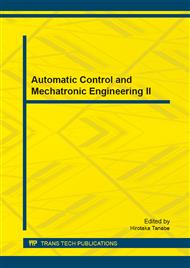p.155
p.161
p.166
p.174
p.180
p.184
p.188
p.192
p.196
Screen Printing Equipment Control System Design Based on PLC
Abstract:
For the traditional operation mode of high strength, low efficiency in the process of the plastic ruler screen printing, the powerful PLC is used as the control core, the automatic PLC control system is developed, and the reasonable programming skills are applied so that the two institutions can work in parallel, which greatly improves the production efficiency. At the same time, sophisticated sensors are used to detect each action execution state so as to ensure that work is reliable with stable performance. Through actual production test, the printing speed has reached the capacity of 28 rulers on average per minute, and has achieved the good production benefit.
Info:
Periodical:
Pages:
180-183
Citation:
Online since:
September 2013
Authors:
Price:
Сopyright:
© 2013 Trans Tech Publications Ltd. All Rights Reserved
Share:
Citation:


